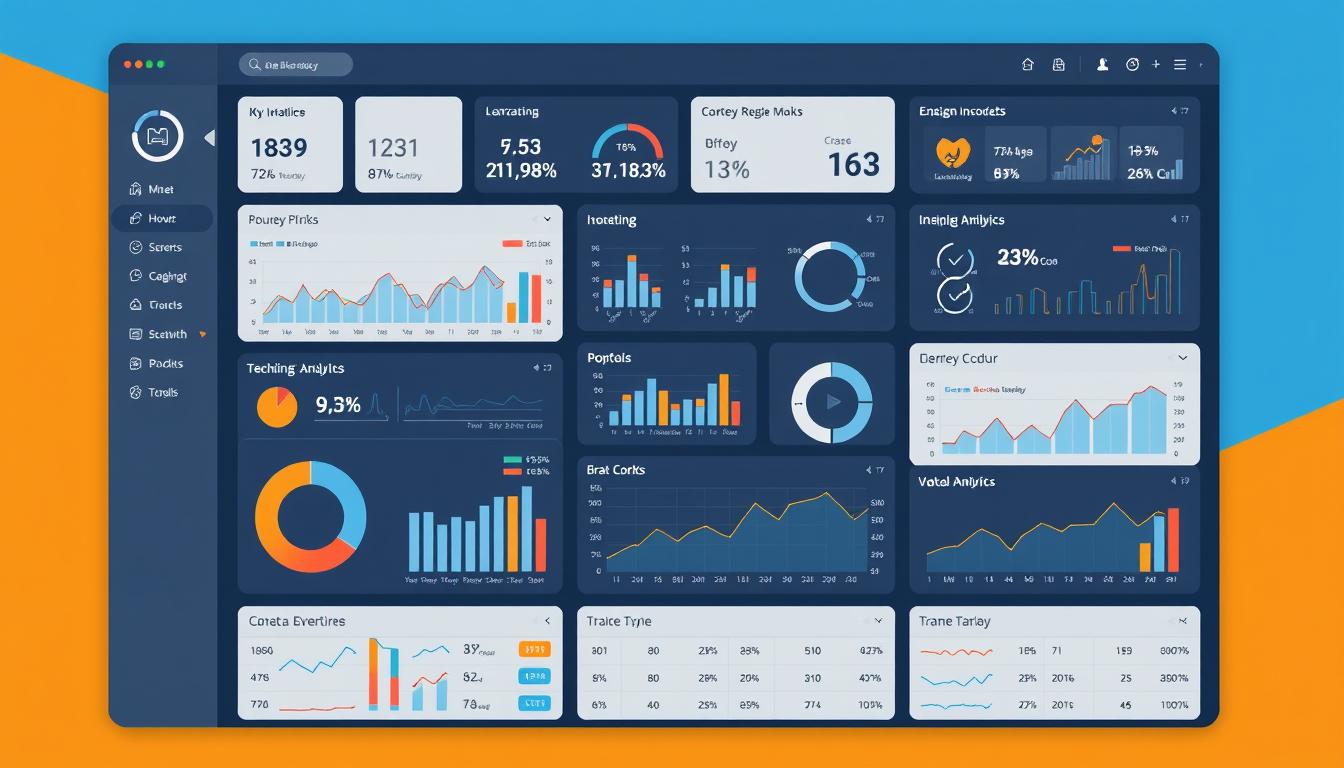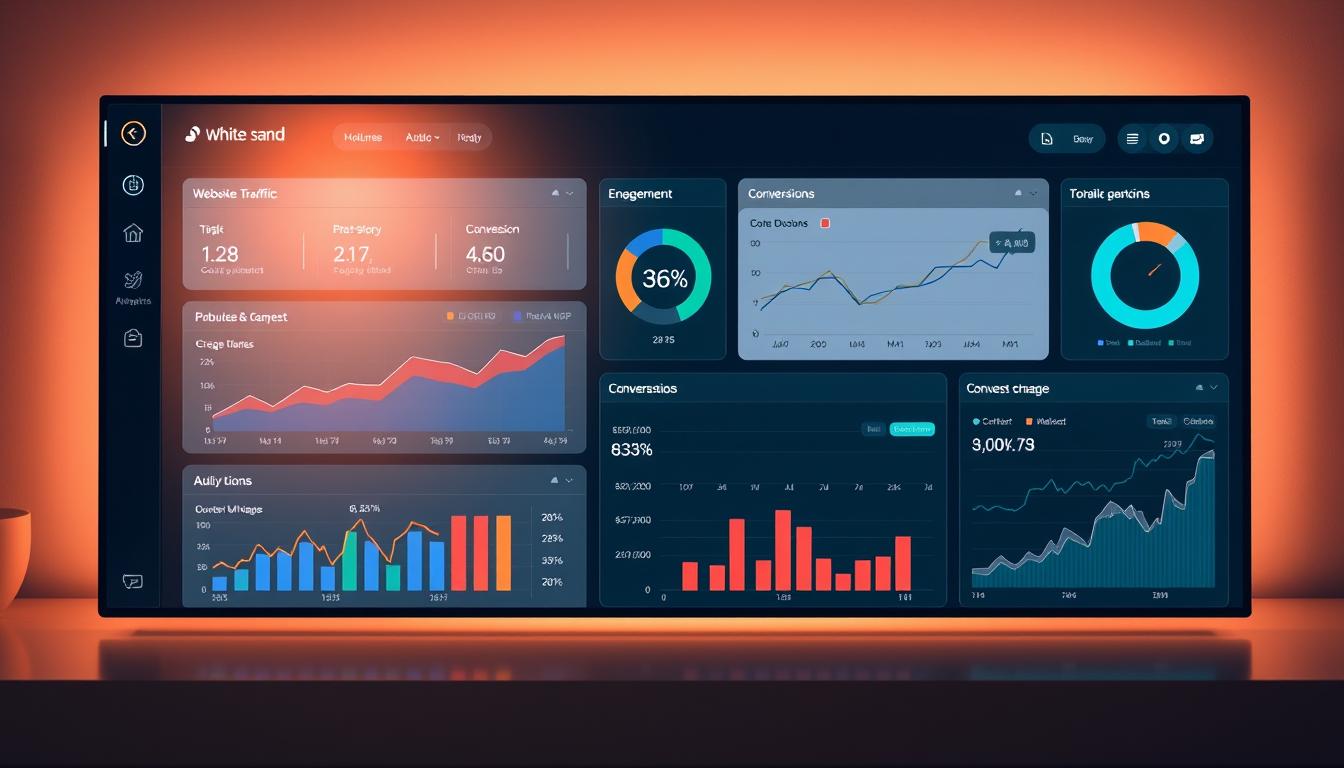
Building a Strong Online Presence: Tips from White Sand
In today’s digital landscape, having a strong online presence is crucial for business growth and sustainability. With people spending eight hours a day on digital activities, it’s no surprise that 97% of consumers go online to research local businesses.
At White Sand, we’ve helped numerous businesses transform their digital footprint. We understand that establishing a cohesive online presence requires more than just a website; it demands a comprehensive strategy that drives real business results and enhances your brand’s visibility.
For more information on how to boost your online presence, contact us at deepali@whitesand.co.in or call (+91)98259-40020. Visit our website at https://whitesand.co.in/ to explore our services.
Key Takeaways
- Understand the importance of a strong online presence for your business.
- Learn how to establish authority and visibility in the digital world.
- Discover comprehensive strategies for website optimization and social media management.
- Get practical tips from White Sand’s experience in transforming digital footprints.
- Create a cohesive strategy that drives real business results.
Why a Strong Online Presence Matters in Today’s Digital Landscape
As consumers increasingly turn to the internet to find and evaluate businesses, a strong online presence becomes essential. In today’s digital age, the way businesses present themselves online can significantly impact their success.
We are now living in an era where 63% of shopping journeys start online. This shift in consumer behavior underscores the importance of being visible and accessible across multiple digital channels. It takes an average of seven encounters with a business before a lead becomes a customer. Being prominent on multiple channels creates opportunities for those engagements to happen more quickly.
The Impact of Online Visibility on Business Success
A strong online presence directly influences business success by enhancing visibility, credibility, and customer engagement. When a business is easily found online, it is more likely to attract potential customers.
| Channel | Impact on Business |
|---|---|
| Search Engines | Primary starting point for consumer research, handling billions of searches daily. |
| Social Media | Crucial for evaluating a business’s reputation through reviews and engagement. |
| Review Sites | Significant in evaluating business credibility and trustworthiness. |
How Consumers Find and Evaluate Businesses Online
Consumers use multiple channels to research businesses before making purchasing decisions. Search engines remain the primary starting point, with Google handling over 3.5 billion searches per day. Social media platforms and review sites also play critical roles in this process.
With the rise of mobile search, “near me” searches have grown exponentially, transforming how consumers find local businesses. Our online presence must be optimized to cater to these changing behaviors.
Understanding the Components of an Effective Online Presence
To establish a robust online identity, it’s essential to understand the components that make up an effective online presence. In today’s digital landscape, businesses need to leverage multiple digital channels to reach and engage their target audience.
Beyond Just Having a Website
Having a website is just the starting point. A comprehensive online presence involves a strategic blend of various digital platforms, including social media profiles, email marketing, and online listings. Each of these channels plays a unique role in enhancing your brand’s visibility and reach.
For instance, social media platforms allow you to engage with your audience, share content, and build brand awareness. Email marketing enables you to nurture leads and foster customer loyalty. Online listings, on the other hand, help improve your local search visibility and credibility.

The Interconnected Nature of Digital Channels
Digital channels don’t exist in isolation; they form an interconnected ecosystem that strengthens your overall online presence. When your media profiles, website, email marketing, and online listings work together, they create a multiplier effect for your brand visibility.
This interconnectedness allows you to repurpose content across different platforms, creating efficiency in your digital marketing strategy. For example, a blog post can be shared on media platforms, and its key points can be incorporated into email newsletters.
By understanding how these channels interact, you can create a cohesive content strategy that guides customers through their journey across different platforms, ultimately enhancing your online presence.
Creating a User-Friendly Website That Converts

A well-designed website is the cornerstone of any successful online presence, directly impacting conversion rates. To achieve this, several key elements must be considered.
Essential Elements of Website Design
An effective website design incorporates several essential elements. First, it must have a clear and intuitive navigation menu that allows visitors to find what they’re looking for quickly. Second, the content should be engaging, concise, and optimized for relevant keywords to improve search engine rankings. Lastly, the website’s layout should be responsive, adapting seamlessly to different screen sizes and devices.
By focusing on these elements, businesses can create a website that not only attracts visitors but also retains them, ultimately driving conversions.
Mobile Optimization Strategies
With the majority of internet users accessing websites through mobile devices, mobile optimization is no longer optional. A mobile-friendly website ensures that your content is easily accessible and navigable on smaller screens. Strategies include adopting a responsive design, optimizing images for faster loading, and simplifying navigation to improve the overall user experience.
By making your website mobile-friendly, you can cater to a broader audience and improve your search engine rankings, as search engines favor mobile-optimized sites.
Security Features That Build Trust
Website security is fundamental to building trust with your visitors and protecting both your business and your customers. Implementing security measures such as SSL certificates (indicated by HTTPS in your URL) is essential for all websites, not just those processing payments. Prominently displaying security badges and trust seals helps reassure visitors that their data is protected.
- SSL certificates are crucial for securing data transmission.
- Implement strong password policies and two-factor authentication.
- Regular security audits and updates help identify vulnerabilities.
- Clear privacy policies build transparency and trust.
- Make sure to comply with relevant data protection regulations.
By prioritizing website security, businesses can safeguard their customers’ data and foster a trustworthy online environment.
Mastering Search Engine Optimization (SEO)

Effective SEO is the backbone of a successful online presence, enabling businesses to reach their target audience more effectively. By mastering SEO, businesses can improve their search engine rankings, driving more traffic to their website and increasing their online visibility.
On-Page SEO Techniques
On-page SEO involves optimizing individual web pages to rank higher in search engines. This includes using relevant keywords in your content, meta descriptions, and titles. Ensuring your website is mobile-friendly and has a fast loading speed is also crucial, as these factors significantly impact search engine rankings.
Another key aspect is the use of header tags (H1, H2, H3, etc.) to structure your content, making it easier for search engines to understand the hierarchy of your page.
Off-Page SEO Strategies
Off-page SEO focuses on building your website’s authority by acquiring high-quality backlinks from other reputable sites. This can be achieved through guest blogging, where you create content for other websites, and by leveraging relationships with influencers and other businesses in your industry.
Consistent NAP (Name, Address, Phone number) information across all online directories is also vital, as it strengthens your local search presence and helps search engines trust your business.
Local SEO for Targeted Visibility
Local SEO is critical for businesses that serve a specific geographic area. By optimizing your Google Business Profile and using local keywords in your content, you can increase your visibility in local search results.
Customer reviews on Google and other platforms significantly impact local search rankings and consumer trust. Encouraging your customers to leave reviews can, therefore, boost your local SEO efforts.
By implementing these SEO strategies, businesses can enhance their online presence, attract more customers, and ultimately drive more sales. Whether you’re focusing on on-page techniques, off-page strategies, or local SEO, the key is to be consistent and adapt to the ever-changing landscape of search engine algorithms.
Building a Strong Online Presence Through Social Media
A strong online presence is significantly bolstered by an effective social media strategy. In today’s digital age, having an active social media presence is crucial for businesses to connect with their audience, build brand awareness, and drive website traffic and sales. To make social media a part of your online presence, you need to have an active account, which means publishing quality posts regularly, responding to likes and comments on those posts, liking and commenting on your followers’ posts, answering direct messages, sharing content from other sources, and more.
Choosing the Right Platforms for Your Business
Selecting the appropriate social media platforms for your business is a critical step. Different platforms cater to different demographics and have unique features. For instance, Instagram is visually-oriented and appeals to a younger audience, while LinkedIn is more professional and geared towards B2B interactions. We should identify where our target audience is most active and focus our efforts on those platforms.
| Platform | Primary Demographic | Content Type |
|---|---|---|
| Younger audience (18-34) | Visual content | |
| Professionals | Professional, B2B content | |
| Broad demographic range | Varied content types |
Creating Engaging Content That Resonates
Creating engaging content is at the heart of a successful social media strategy. Quality content should be informative, entertaining, or inspiring. We need to understand our audience’s preferences and tailor our content accordingly. Using a mix of educational, promotional, and engaging content can help maintain audience interest and avoid fatigue.
For example, a company could share a tutorial related to their product, followed by a promotional post highlighting a special offer, and then an engaging post asking for feedback or opinions.
Developing a Consistent Posting Schedule
Consistency is key to maintaining visibility in social media algorithms and staying top-of-mind with our audience. Developing a content calendar that plans posts in advance while allowing flexibility for timely or trending topics is essential. Optimal posting frequencies vary by platform, so researching the best times and days to post for our specific industry and audience is crucial.
- Plan content in advance using a content calendar.
- Use scheduling tools to maintain consistency.
- Balance promotional content with educational and engaging posts.
- Allocate time for community management.
Content Marketing Strategies That Drive Traffic
In today’s digital landscape, a well-planned content marketing strategy is vital for attracting and retaining customers. To drive traffic to your website, you need to create valuable content that resonates with your target audience.

Blogging for Business Growth
Blogging is a powerful way to establish your brand as a thought leader in your industry. By creating informative and engaging blog posts, you can attract potential customers and drive traffic to your website. To maximize the impact of your blog, focus on topics that are relevant to your audience and optimize your posts with relevant keywords.
Video Content Creation Tips
Video content is becoming increasingly popular, and it’s an effective way to convey complex information in an engaging format. To create successful video content, focus on storytelling and use high-quality visuals. You can repurpose your blog posts into video content, such as explainer videos or tutorials, to reach a wider audience.
Repurposing Content Across Platforms
Repurposing content maximizes your return on investment by extending the life and reach of your marketing assets. A single piece of cornerstone content can be transformed into multiple formats tailored to different platforms and audience preferences. For example, you can turn blog posts into infographics, podcasts, video tutorials, social media snippets, or email newsletters. By adapting content to suit the unique characteristics of each platform, you can save valuable time and resources while ensuring a consistent presence across multiple channels.
Leveraging Email Marketing for Customer Engagement

Email marketing stands out as a pivotal strategy for enhancing customer engagement. By building a robust email list and crafting compelling newsletters, businesses can foster strong relationships with their audience.
Building and Segmenting Your Email List
To encourage more sign-ups for your email marketing list, it’s advisable to add an opt-in form to your website, especially on high-traffic pages. You could also use exit-intent popups to capture visitors before they leave your site. Regularly updating your email list by removing inactive subscribers is crucial for maintaining a healthy list and complying with email marketing laws like GDPR and CAN-SPAM.
Creating Newsletters That Get Opened
Crafting newsletters that get opened involves several key strategies. Compelling subject lines are crucial for improving open rates—they should create curiosity or clearly communicate value. Personalization goes beyond using the recipient’s name; it includes tailoring content based on their interests and behaviors. Moreover, with over 60% of email opens occurring on mobile devices, mobile optimization is essential.
Timing also matters; testing different sending days and times helps identify when your specific audience is most responsive. Keeping your design clean and scannable with a clear hierarchy of information and prominent calls-to-action is vital. Providing genuine value in every newsletter, whether through educational content, exclusive offers, or insider information, keeps your audience engaged.
Online Reputation Management
As consumers increasingly rely on online reviews, maintaining a positive online reputation is vital. We must monitor what customers are saying about our company regularly to identify areas for improvement and demonstrate our commitment to customer satisfaction.
Monitoring and Responding to Reviews
Responding quickly to online reviews, especially negative ones, is crucial. We should approach criticism with genuine curiosity and a desire to understand the customer’s experience. By responding publicly to acknowledge the issue and then moving the conversation to a private channel to resolve it, we can turn a negative into a positive.
- Respond promptly to all reviews, both positive and negative.
- Acknowledge the customer’s concern and show empathy.
- Move the conversation to a private channel to resolve the issue.
Turning Negative Feedback into Opportunities
Negative feedback provides valuable opportunities for business improvement and relationship building. When handled well, resolving a negative experience can create stronger customer loyalty. We should use feedback patterns to identify systemic issues and follow up with dissatisfied customers after resolving their issues to demonstrate our commitment to their satisfaction.
“The goal is to turn negative feedback into positive outcomes.” By sharing how we’ve implemented changes based on feedback, we show that we value customer input and are committed to continuous improvement.

Paid Advertising Strategies for Increased Visibility

Paid advertising is a key component of a successful online presence, offering businesses a way to reach their target audience directly. By leveraging the right paid advertising strategies, companies can significantly increase their online visibility and drive conversions.
Search Engine Advertising (PPC)
Search Engine Advertising, commonly known as Pay-Per-Click (PPC), allows businesses to display ads on search engines like Google. By targeting specific keywords, businesses can ensure that their ads appear in front of users who are actively searching for related products or services. This targeted approach can lead to higher conversion rates.
Social Media Advertising Options
Social media platforms offer a wide range of advertising options that can be tailored to specific business goals. From Facebook and Instagram to LinkedIn and Twitter, each platform provides unique targeting capabilities based on user demographics, interests, and behaviors. By choosing the right social media channels, businesses can effectively reach their target audience and drive engagement.
Retargeting Campaigns for Higher Conversion
Retargeting campaigns focus on the 95-98% of website visitors who leave without converting, offering a second chance to engage them. By showing targeted ads to these users as they browse other sites or social media, businesses can encourage them to return and complete a purchase. Effective retargeting involves segmenting audiences, implementing frequency caps, and creating a logical sequence of ads to guide prospects through the buyer’s journey.
By incorporating these paid advertising strategies into their overall online presence plan, businesses can enhance their visibility, drive more traffic to their website, and ultimately achieve better results from their online marketing efforts.
Working with Influencers to Expand Your Reach

As we navigate the complexities of online marketing, collaborating with influencers emerges as a key tactic for reaching wider audiences. Influencer marketing has proven to be highly effective, with Influencer Marketing Hub estimating a sales return of $5.20 for every $1 spent.
Identifying Relevant Influencers in Your Niche
To leverage influencer marketing effectively, it’s crucial to identify influencers who align with your brand values and target audience. This involves researching their content, engagement rates, and audience demographics to ensure a good fit.
Creating Mutually Beneficial Partnerships
Successful influencer partnerships are built on mutual benefit, delivering value to both the brand and the influencer, as well as their audience. To achieve this, we should approach relationships with influencers as long-term partnerships, clearly defining expectations and deliverables, and allowing creative freedom within brand guidelines to produce authentic content. By doing so, we can measure the results of our collaborations effectively and foster genuine relationships that drive long-term success.
By tracking the success of individual influencer collaborations using tools like Google Analytics and UTM tracking codes, we can refine our strategies and ensure that our brand is represented authentically and effectively across various influencer channels.
Measuring and Analyzing Your Online Performance
To gauge the effectiveness of our online efforts, we must regularly measure and analyze our online performance. This involves tracking key metrics and utilizing various tools to monitor our digital presence.
Key Metrics to Track
To understand our online presence, we need to focus on several key metrics. These include website traffic, engagement rates on social media, email open rates, and conversion rates. By monitoring these metrics, we can identify areas that require improvement and adjust our strategy accordingly. For instance, if our website traffic is low, we may need to revisit our SEO strategies or invest in targeted advertising.
Regularly reviewing analytics data allows us to monitor our performance over time and make necessary adjustments to our strategy. This data-driven approach ensures that our online efforts are aligned with our business goals.
Tools for Monitoring Your Digital Presence
A comprehensive analytics stack combines multiple tools to provide a complete picture of our online performance. Some essential tools include:
- Google Analytics for website performance tracking
- Social media management tools like Hootsuite or Buffer
- SEO tools such as SEMrush or Ahrefs
- Brand monitoring tools like Mention or Brand24
- Email marketing platforms for detailed metrics
- Customer feedback tools for gathering direct input
- Data visualization tools for transforming complex analytics into actionable insights
By leveraging these tools, we can streamline our monitoring and response processes, ultimately enhancing our online presence. For example, using review management tools can help us respond promptly to customer feedback across multiple platforms.

White Sand’s Approach to Building Strong Online Presence
Our approach to building a strong online presence is centered around creating a tailored strategy that meets the unique needs of each business. We take a holistic approach, recognizing that each business has distinct goals and target customers.
At White Sand, we begin with comprehensive research to understand your industry, competitors, and target audience. Our methodology emphasizes creating a cohesive brand image across all digital touchpoints. We believe in sustainable growth tactics that build long-term presence rather than quick fixes.
- Data-driven decision making guides our approach, with regular performance analysis and strategy adjustments.
- We prioritize authentic engagement and relationship building over vanity metrics.
To learn how we can help strengthen your brand’s online presence and improve your image, contact us at deepali@whitesand.co.in or call (+91)98259-40020. Visit our website at https://whitesand.co.in/ for more information.

Conclusion: Taking the First Steps Toward a Stronger Online Presence
As we conclude our discussion on building a strong online presence, it’s essential to remember that this is an ongoing process. Building a strong online presence is not a one-time effort, but a commitment that evolves with your business and the digital landscape.
To get started, focus on the fundamentals: a well-designed website, consistent business listings, and active profiles on relevant social platforms. Prioritize quality over quantity in all aspects of your online presence. Develop a realistic strategy based on your available resources, and remember that results take time.
For personalized guidance on building your online presence, contact White Sand at deepali@whitesand.co.in or call (+91)98259-40020. Visit our website at https://whitesand.co.in/ for more information on enhancing your brand‘s online presence.
FAQ
What are the key elements of a successful online marketing strategy?
We believe that a successful online marketing strategy involves creating a user-friendly website, leveraging social media platforms, and implementing effective SEO techniques to increase visibility and drive traffic to your site.
How can I improve my website’s visibility on search engines?
To improve your website’s visibility, we recommend optimizing your site with relevant keywords, creating high-quality content, and ensuring a smooth user experience.
What is the importance of content marketing in digital marketing?
Content marketing is crucial as it helps attract and engage your target audience, driving conversions and ultimately boosting sales.
How can influencer marketing help my business?
Influencer marketing can help expand your brand awareness, reach new audiences, and drive sales by partnering with influencers who have a genuine interest in your products or services.
What are the benefits of using paid advertising online?
Paid advertising can increase your visibility, drive traffic to your site, and generate leads and sales by targeting specific audiences and demographics.
How can I measure the success of my online presence?
We recommend tracking key metrics such as website traffic, engagement rates, and conversion rates to measure the success of your online presence.
What is the role of email marketing in customer engagement?
Email marketing plays a crucial role in customer engagement by allowing you to build relationships, share relevant content, and drive conversions through targeted campaigns.
